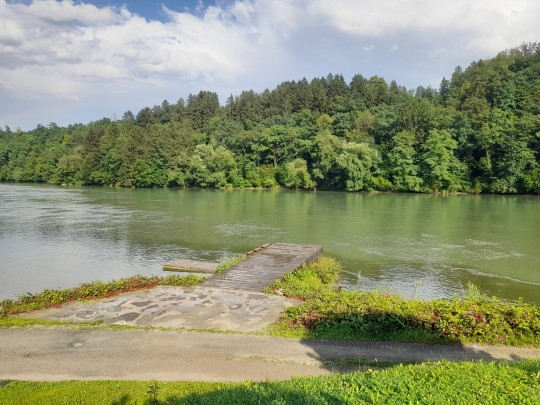#Koroška
Text



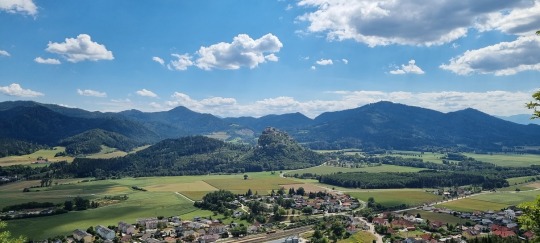

Hochosterwitz Castle (German: Burg Hochosterwitz, Slovene: Grad Ostrovica) is a castle in Carinthia, considered one of Austria's most impressive medieval castles. It is on a 172-metre (564 ft) high dolomite rock near Sankt Georgen am Längsee, east of the town of Sankt Veit an der Glan.
#Hochosterwitz Castle#Burg Hochosterwitz#Grad Ostrovica#Замок Хохостервиц#Ostrovica#Launsdorf#medieval#Mittelalter#St. George#Längsee#St. Georgen am Längsee#St. Veit an der Glan#Kärnten#Carinthia#Austria#Šentjurij ob Dolgem jezeru#Šentvid ob Glini#Koroška#Avstrija#Österrreich#Oostenrijk#Österrike#Австрия#Каринтия#Carinzia#Carinthie#Autriche
20 notes
·
View notes
Photo
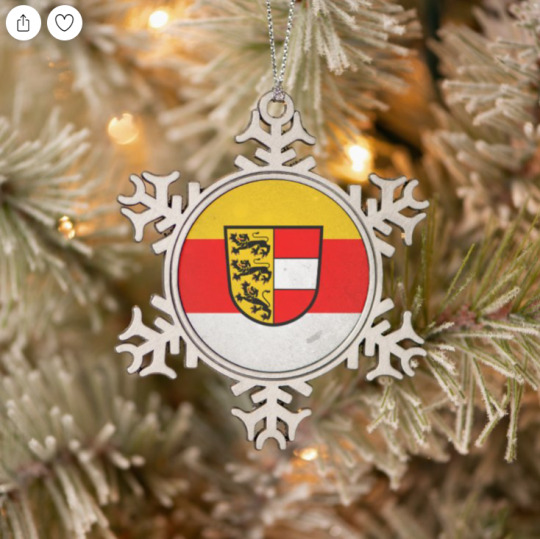


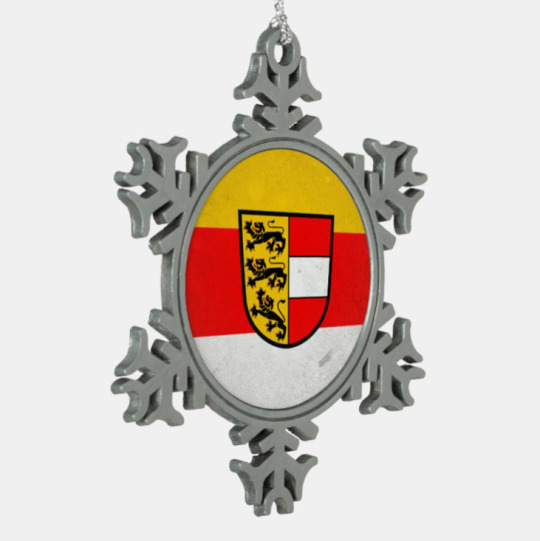


Pewter Snowflake Ornament
Dimensions: 3"h x 3"w x 0.125"d
Customizable face printed in full color on 1.625" aluminum insert
Pewter flat ornament with silver hanging thread
#ornament#carinthia#Kärnten#Koroška#austria#austrian#alps#mountains#holidays#snowflake#ornamental#decoration#holiday decoration#aluminum#pewter ornament#celebration#xmas time
0 notes
Text
on one hand I'm curious whether the JO boys have ever been to my hometown in Austria, but on the other hand I don't want anyone ever to see my hometown
3 notes
·
View notes
Text
Pride, slovenska verzija 🏳️🌈🇸🇮
(Pride, but all characters are wearing Slovenian folk clothes)
Rainbow flag - Gorenjska (Upper Carniola)
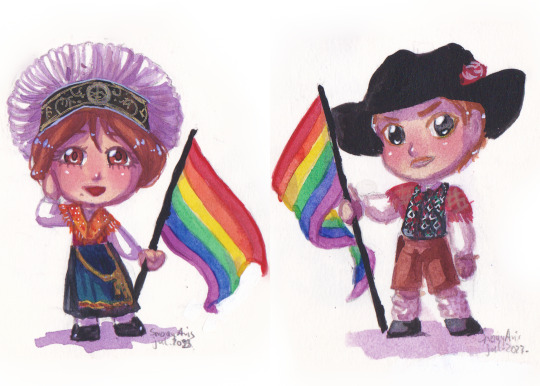
Bi - Koroška (Carinthia)
Pan - Dolenjska (Lower Carniola)

Trans guy - Vzhodna Štajerska (Eastern Styria)
Trans girl - Zahodna Štajerska / Savinjska dolina (Western Styria / Savinja valley)
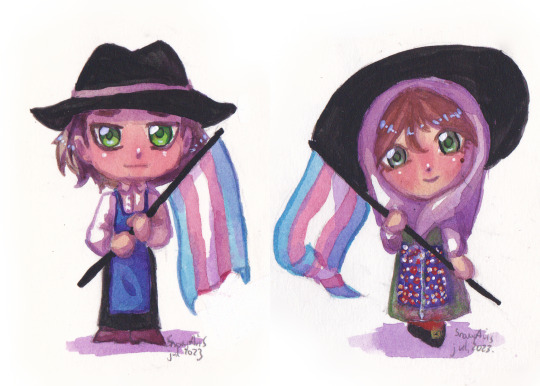
Lesbian - Istra
Genderfluid - Notranjska (Inner Carniola)
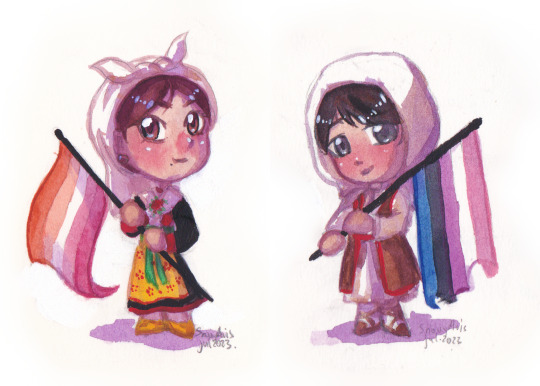
Genderqueer - Beneška Slovenija ((Slavia Friulana)
Non-binary - central Slovenia

Ace - Prekmurje
Aro - Bela Krajina (White Carniola)
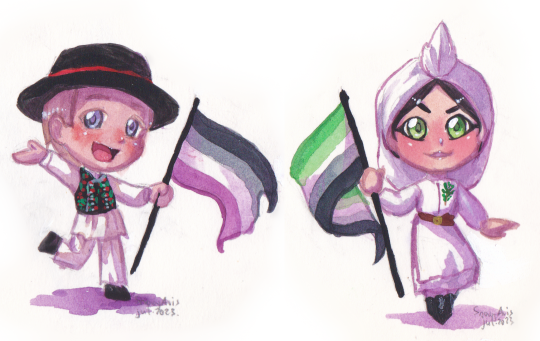
And last but not least... 🏳️🌈 Pride Korant 🏳️🌈

#art#traditional art#water colour art#folk dress#slovenian#slovenia#slovenija#south slavic#slavic#slavs#balkan#balkans#queer#lgbtqai#gay#lesbian#bisexual#pansexual#asexual#aromantic#nonbinary#transgender#genderqueer#genderfluid#trans#ace#aro#bi#pan#pride
118 notes
·
View notes
Text
youtube
ENG Translation of Vecer.com article, translation cr: @kurooscoffee, video transcript: drumbeat
(PHOTO and VIDEO) Joker Out at Lent Festival heated up the Maribor audience: Crowd of teenagers* at Leon Štukelj Square
Last night's highlight of the first Lent Festival weekend
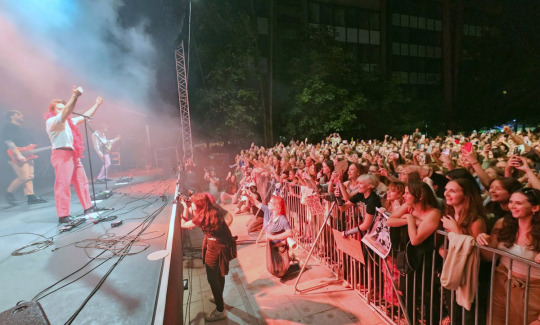
Photo: SAŠO BIZJAK
Maribor was heated up, streets were packed, and there was a crowd full of teenagers* on Leon Štukelj Square. Everything was ready for the concert of the stars, the Joker Out band, who were the highlight of the first weekend of Lent Festival. As we waited to get in and catch the band before the concert, we spoke to Alja from Maribor. "I've been following them since 2018. Back then they had a concert at Lent, and there were ten of us, it was free. It's really good that they managed to do succeed like this now," said the enthusiastic fan*. We caught up with them right after soundcheck and a few other commitments on stage.

Photo: SAŠO BIZJAK
Carpe Diem live in Maribor for the first time
"We have really appeared on stage here in Maribor many times in the last few years, it has been nice to see the crowd getting bigger and louder, we are always very warmly welcomed and we really love coming back here. But in 2018, our first concert at Lent Festival was on the Večer stage, I remember it was raining, there were canopy tents set up, there were just enough people to hide under those four or five tents. Today, I don't think that would be possible anymore," the good-humoured Bojan Cvjetićanin told us. The boys remarked that there would definitely be no rain this evening, because 'we're going all out with partying (1)', and promised to play their entire repertoire for Maribor. "We know both us and them will enjoy it. It will be the first time Carpe Diem will be performed live in Maribor. A premiere," added Cvjetićanin.
(1) T/N this part was said in Maribor dialect
And indeed. There was no rain that evening, and the temperature was very suitable for warming up the enthusiastic crowd. Done as promised. In an hour and a half they provided a medley of songs from the first and second album. They started with Katrina, continued with Ne Bi Smel, Plastika, Dopamin, A Sem Ti Povedal Kdaj, Padam, Demoni, Srce ocena, Metulji, Vse Kar vem, Vem Da Greš… When she discovered the latter song, she started listening to them, the 29-year-old Eva from Maribor told us. "I've been following them for about three years, I've been to their concert in Ptuj, and I've been cheering for them at Eurovision. I like their magnetic energy. Because they are genuine, exactly as they are. They have a special depth in their lyrics that you can find yourself in. They fit Lent, they bring a youthful energy to it. May they come to Maribor many more times," she said. Teja, 17, from Maribor, has been following Joker Out for about a year and her favourite song is Metulji. Her friends Metka and Romina have been following them since Eurovision. They like them because they have a new touch and because the lyrics are a bit different and not so superficial, they told us.
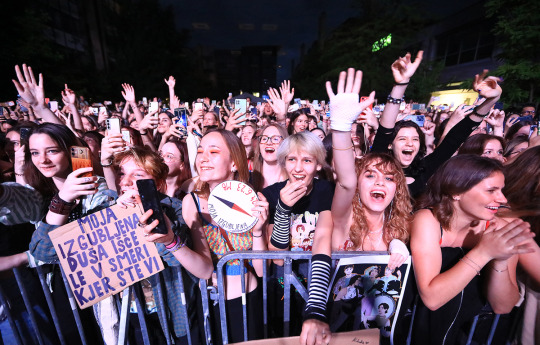
Leon Štukelj Square was full of enthusiastic fans∗. PHOTO: SAŠO BIZJAK
The best concert ever for a Canadian*
Although the concert was, clearly, mostly young people, there were also some older female fans in the crowd. "Our whole family listens to Joker Out. The biggest fan is my granddaughter, who is two years old, but she couldn't come to the concert with us (yet). The rest of us came from Koroška (T.N.: region in northern Slovenia) for the concert," said Andreja from Vuzenica.

PHOTO: SAŠO BIZJAK
As Bojan already noted on stage, it wasn't only the local fans who were listening to them in Maribor. Anna Herran from Canada travelled a lot more kilometres than anyone else to be able to listen to them in Maribor. "I am currently studying in Prague," she explained. She spotted them at Eurovision. "'Well done!' After that I really wanted to go to their concert, I saw their summer tour and I came from Prague yesterday. I've been to Slovenia before, I really like it, but never to Maribor, so it was a great opportunity to combine one with the other. It was the best concert I've been to so far! Everyone is taller than me, so I didn't see some parts, but it was still great, I really want to go to another concert of theirs, I hope that one day they will come to Canada; or Prague, which is closer to them," the smiling 28-year-old told us after the concert. She particularly likes that they sing in Slovenian, and sometimes in Serbian, she added. "When you live in North America, everything is always in English, so it's great to hear other languages. Now that I'm here, I can even say a few things in Slovene. 'Hvala lepa!' That's what I learned from them. And the fans∗ translate the texts online, which I really appreciate," she added.
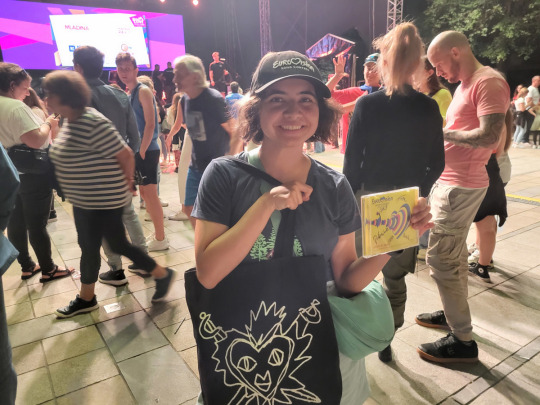
Anna Herran, Canadian, fan of Joker Out (PHOTO: URŠKA POLANC)
"No, I'm not signing your passport …"
Now that they have already performed abroad, we were curious to see how the band feels standing on Slovenian, home stages. What is the difference? "We like anyone who sings our music in Slovenian," Jan Peteh answered. Kris Guštin added that there is less difference between Slovenian and foreign stages than they thought there would be. "Absolutely, we thought that Slovene would be a really big hurdle between us and the audience, but it turned out that it's not the case. It even turned out that this kind of barrier that the language sets is a very fun challenge for the fans, because they are very relaxed about the concert and they are ready to absorb everything that we give them. On stage we feel very primal, very childlike, and so do the fans∗," explained Cvjetićanin. Are they now more confident on stage after Eurovision? "I think the difference is quite noticeable, especially if we have pink clothes on stage," Peteh added, laughing.

PHOTO: SAŠO BIZJAK
During the concert, many objects flew onto the stage, some of them off it. The singer said that he already has a room full of presents at home, but he is always happy to receive new ones. "That T-shirt I signed was not an invitation to throw all the items of clothing on stage." "No, I'm not signing your passport," the band's singer, among other things, told the audience, from whom they also said goodbye in style. "We've saved it for last because it suitably describes the continuation of the evening … Carpe Diem!"
ENG Translation by @kurooscoffee (jokeroutsubs) DO NOT REPOST!
#because we know people will ask: upper asterisk* indicates female form while lower asterisk∗ indicates either male OR neutral form#this is what we mean when we say that it is quite impossible to stay gender neutral in slovenian...#Also this is a personal observation but the boys are really inclusive and I only remember hearing them address their fans in gender neutral#and they also like to point out that it's not just 'teenage girls' listening - it's everyone including older women AND guys#I'll try to find the specific interview where they point this out (though I think it probably wasn't just one but several!)#joker out#bojan cvjeticanin#jure macek#jan peteh#kris gustin#nace jordan
59 notes
·
View notes
Text



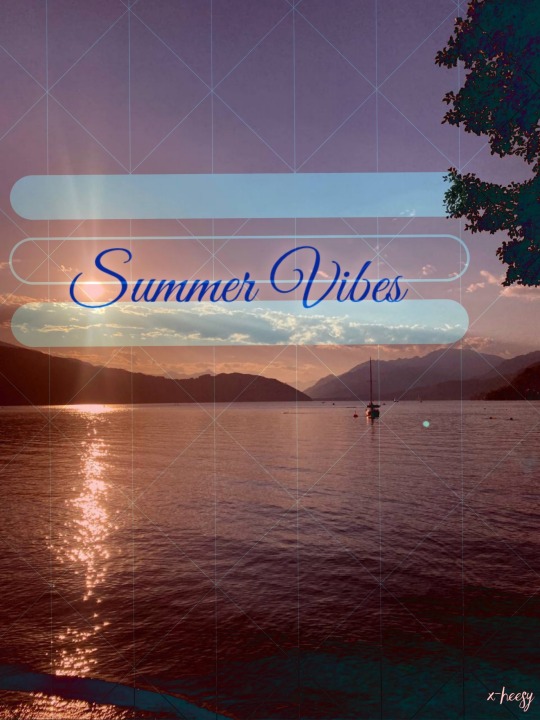


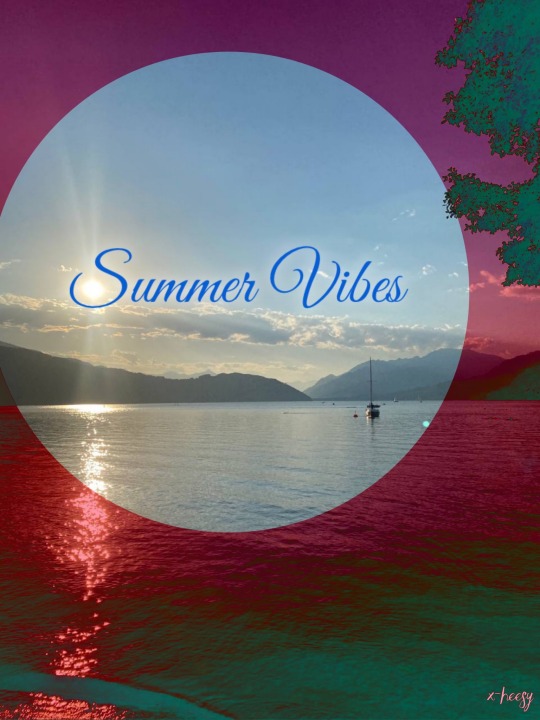
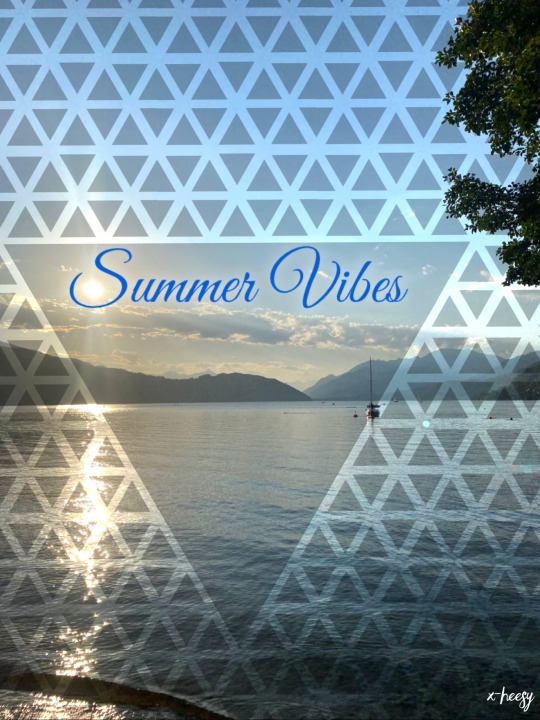

Summer Vibes 🇦🇹
Carinthia (German: Kärnten [ˈkɛʁntn̩] Slovene: Koroška [kɔˈɾóːʃka], Italian: Carinzia) is the southernmost Austrian state, in the Eastern Alps, and is noted for its mountains and lakes. The main language is German. Its regional dialects belong to the Southern Bavarian group. Carinthian Slovene dialects, forms of a South Slavic language that predominated in the southeastern part of the region up to the first half of the 20th century, are now spoken by a small minority in the area.
@darksilenceinsuburbiareloaded 😘 🛥️ ☀️ 🧭
Parov Stellar - Homesick 🇦🇹

#l o v e#x-heesy#my art#artists on tumblr#8/2023#travelingwithoutmoving#where are my hashtags fuckaz#carinthia#Carinzia#kärnten#Austria#österreich#traveling#iphonography#iphone art#pop art#neo pop art#summer vibes#aesthetic#music and art#contemporaryart#newcontemporary#new contemporary#new contemporary art#Proud 🆎out
14 notes
·
View notes
Text
Zagreb is the capital city of Croatia. But till the XVI-th century wasn't even part of Croatia. It was one of capital cities of Kingdom of Slavonia.
During Roman Empire, today's northern part of Croatia was roman county Panonia Minor. After the fall of the Western Roman Empire, franks acquired the title of Roman Empire and transfered former counties to duchies, vasals of frank kings. So Panonia Minor became "Duchy between Sava and Drava" (rivers).
During VI-th and VII-th century slavic people settled eastern duchies of franks empire: Bohemia (Czechia), Moravia, Nitra (Slovakia), Carantania (Körnten in Austria and Koroška in Slovenia), Styria (Steiern/Štajerska), Carinthia (Kranjska), Duchy between Sava and Drava, Croatia, Zahumlje, Duklja, Raška. In the IX-th century, all that duchies except the last four on Balkan, united under the same king independent from franks, with the capital in Brno. Latin name for that kingdom was Sclavonia, but it was better known as The Great Moravia (Velka/Velika Moravska).
In the X-th century hungarians came to Panonia and practicaly cutted the kingdom to two parts. From that time is Duchy between Sava and Drava know as Duchy of Slavonia, from latin name Sclavonia for the former kingdom. Hungarian name for that duchy, later kingdom was Slovenia and citizens call it Slovenje. For the same reason probably Slovakia today has it's name, called by citizens Slovensko.
On the begining of the XVI-th century Kingdom of Slavonia became part of the Habsburg Empire, later also Croatia. As about 90% of Slavonia and 90% of Croatia was occupated by Turkey, Habsburgs decided to unite two kingdoms with the capital Zagreb (Agram), so they can easier organize defence. Till 1914. official name was Kingdom of Croatia and Slavonia.
In north Croatia, former Kingdom of Slavonia, is spoken so called kaikavian dialect. That dialect is now much more close to croatian language, than it was in history, because of influence of official language, but still people from southern Croatia don't understand about 30% of that dialect, while slovenians understand all. All differences from croatian language is actualy slovenian words,so it is obvious that kaikavian is actualy dialect of slovenian language.
Today's Slovenia wasn't known under this name till the end of the IIWW. That were three duchies: Carantania, Carinthia and Styria. The first known (written) slovenian duke was Valuk, duke of Carantania in VII-th century. During history Carantania and Styria were populated by german people, so after the IWW slovenians were 42% of population in Carantania. Bigger parts of Carantania and Styria are now in Austria, while smaller parts in Slovenia.
In the XVI-th century many towns in Carantania, Carinthia and Styria changed names to emphasize it's slovenian identity: Gradec became Slovenj Gradec, Bistrica became Slovenska Bistrica, and so on. On the same time, in Zagreb was pressed the first book. It was about world history and on the first page is written that it is in slovenian language (v slouenskem jazyku). So it is obvious that people in Kingdom of Slavonia, and duchies of Carinthia, Carantania and Styria shared the same identity and language.
I was born in Zagreb, I speak kaikavian dialect, my father fill to be croat, as well as my mother when was still alive. So I also every time declare myself as croat. Most people in northern Croatia fill to be croats, and that should be respected. But it is good to know that we actualy have slovenian roots.
25 notes
·
View notes
Note
živjo. bi mi znal razložit, kako je bilo zgodovinsko s črko oziroma glasom “(dolgi) jat” v slovenščini? in kateri glas je to sploh bil. hvala :)
hej!
Jat je glas, ki se ga ponavadi identificira z nizkim/širokim sprednjim samoglasnikom [æ] (v standardni slovenščini ga ni, obstaja pa v določenih narečjih, pomagaš pa si lahko z razliko med ang. bet, v katerem je široki [ɛ], proti ang. bat z [æ] – torej glas med širokim e in a), pred katerim je morda stal šibek glas [j]: [⁽ʲ⁾æ]
V praslovanščini so bili nekateri samoglasniki inherentno dolgi, nekateri pa inherentno kratki, ne glede na to ali so stali pod naglasom ali ne. Kratki so bili e, o, ь, ъ (zelo kratka in ošibljena i in u) dolgi pa i, y (t. i. „trdi i“, kot v rus. рыба), u, ę, ǫ (nosna e in o), a in seveda ě.
Dodaten vir za jat po praslovanskem obdobju je metateza likvid, v okviru katere je iz prvotnih zaporedij TerT, TelT v zgodnji južni slovanščini nastalo TrěT, TlěT (melko > mlěko).
V zgodnji slovenščini se je nato zgodila sprememba v sistemu dolžine in naglasa samoglasnikov, ki ju je privedla skupaj: kar je bilo pod naglasom je bilo (načeloma) dolgo (nekateri kratki samoglasniki so se torej podaljšali), kar je bilo nenaglašeno je bilo kratko (nekateri dolgi samoglasniki so se torej skrajšali). Tako dobimo dolgi in kratki jat.
Obenem je za razvoj jata pomemben tudi razvoj nosnih ę in ǫ: na območjih, kjer sta se ę in ǫ zgodaj denazalizirala, sta postala široka [ɛ] in [ɔ], sočasno pa se je jat zožal v [e]. Kjer sta ostala nazalna, je tudi jat ostal širok. V SZ slovenščini, vzhodni južni slovanščini (bolgarščina, makedonščina) in severni zahodni slovanščini (oz. lehitski zahodni slovanščini: poljščina, kašubščina, pomorjanščina) do denazalizacije ali ni prišlo ali pa se je zgodila pozno.
Zdaj torej govorimo o razliki med razvojem jata v SZ slovenščini (koroška, obsoško-idrijska in beneško-kraška narečja), kjer je ostal širok, napram JV slovenščini (gorenjska, dolenjska, severno- in južnoštajerska ter panonska narečja), kjer se je zožal.
Pod naglasom, kjer je bil dolg (*z izjemo starega akuta, kjer je ostal kratek), se je jat nato diftongiral – postal je dvoglasnik: na SZ i͜e, na JV ei̯ (li͜es proti lei̯s za standardno les) – to gre z roko v roki s spremembo dolgega o v SZ u͜o in JV ou̯ (nu͜oč proti nou̯č za standardno noč). V gorenjščini sta se nazaj monoftongizirala v ozki e in o, od koder današnje stanje v knjižnem jeziku. (Lahko bi rekli torej, da je SZ slovenščina íjekavska, JV pa ejkavska lol – knjižni jezik pa ekavski)
6 notes
·
View notes
Text
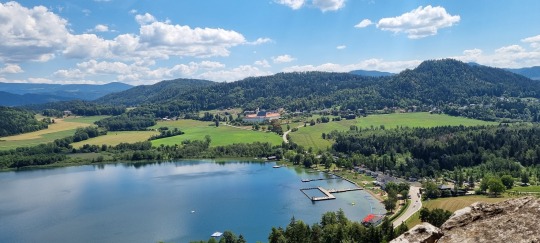


Lake View from the Längseekogel across the Längsee to St. George’s Abbey, a Benedictine monastic complex in the village of Sankt Georgen am Längsee, Carinthia, Austria. It celebrated its 1,000th anniversary in 2003.
Seeblick vom Längseekogel über den Längsee auf das Stift St. Georgen am Längsee, ein ehemaliges Kloster der Benediktinerinnen, gegründet nach 1002 in der Gemeinde Sankt Georgen am Längsee im Bezirk St. Veit an der Glan in Kärnten.
Pogled z gore Längseekogel na Dolgo jezero in nekdanji benediktinski ženski Samostan Šentjurij ob Dolgem jezeru, ustanovljen po letu 1002, je v okraju Šentvid ob Glini na avstrijskem Koroškem.
#St. George#St. George's Abbey#Stift St. Georgen#Längsee#benedictine#Benediktiner#samostan Šentjurij#Dolgo jezero#long lake#St. Georgen am Längsee#St. Veit an der Glan#Kärnten#Carinthia#Austria#Šentjurij ob Dolgem jezeru#Šentvid ob Glini#Koroška#Avstrija#Österrreich#Sint-Jorisstift#Oostenrijk#Klostret Sankt Georgen#Österrike#دير القديس جورج#النمسا#Längseekogel#lake view#Seeblick#pogled na jezero
5 notes
·
View notes
Text
Černač: To je razlog, da Koroška in Savinjska nimata protipoplavne zaščite in je tudi ne bosta imela
S pomočjo opozicije je državni zbor včeraj zvečer z odločitvijo, da o interventnem popravku zakona o odpravi posledic naravnih nesreč ni mogoč referendum, omogočil, da bo sprememba za pomoč prizadetim v poplavah takoj objavljena in da že velja. Že prej je s hitro odločitvijo, da ne bo veta, k temu prispeval tudi državni svet. Na kratki seji državnega zbora je bil zanimiv nastop predstavnika…

View On WordPress
0 notes
Text
Europeada 2024 - "between the seas"

Europeada 2022 in Kärnten/Koroška, Austria.
In the beginning of this March, the sorbian woman's football Team met for the first training in Ralbitz/Ralbicy: The Sorbs & Domowina planned to organize a woman's team next to the already existing men's team for the next great international tournament, the Europeada 2024.
The Europeada is a football League existing since 2008 for European minorities, and is going to take place next to Flensburg next year, from the 28th June to 7th july. Hosts are the Danes of Germany, Germans of Denmark, Rroma/Sinti, and the Frisians.
The Sorbs had already been hosts of the Europeada in 2012 in Bautzen/Budyšin.
#german football#football#european football#European minorities#Europeada#Europeada 2024#Europe#minority#minority languages#file: unspecified
1 note
·
View note
Photo

630) European Free Alliance (EFA), Alliance libre européenne, ALE, Wolny Sojusz Europejski (WSE) (zwany również Europa Stu Flag) - europejska organizacja grupująca ugrupowania polityczne „narodów bez państw”. Partie te żądają albo autonomii, albo pełnej niepodległości dla swoich narodów. W Parlamencie Europejskim, WSE tworzy wspólną grupę z Zielonymi pod nazwą Zieloni/WSE.
Ugrupowania członkowskie:
Austria:
Karyncka Lista Jedności (niem. Kärntner Einheitsliste, słoweń. Koroška enotna lista)
2. Belgia:
Nowy Sojusz Flamandzki
3. Bułgaria:
Omo Ilinden Pirin
4. Chorwacja:
Lista za Rijeku
5. Czechy:
Morawianie (Moravané)
6. Dania:
Schleswigsche Partei
7. Finlandia:
Alandzka Przyszłość (Ålands Framtid)
8. Francja:
Mouvement Région Savoie
Unia Ludu Alzackiego (Union de Peuple Alsacien)
Demokratyczna Unia Bretanii (Union Democratique Breton)
Partia Narodu Korsykańskiego (kors. Partitu di a Nazione Corsa)
Partit Occitan (PÒc)
Unitat Catalana
9. Grecja:
Partia Tęczy Vinozhito (gr. Ευρωπαϊκή Ελεύθερη Συμμαχία)
10. Hiszpania:
Partia Aragońska (Partido Aragones)
Aralar
Eusko Alkartasuna
Republikańska Lewica Katalonii (kat. Esquerra Republicana de Catalunya)
Partit Socialista de Mallorca
Nacjonalistyczny Blok Galicji (gal. Bloque Nacionalista Galego)
Bloc Nacionalista Valencia
11. Holandia:
Narodowa Partia Fryzji (Fryske Nasjonale Partij)
12. Niemcy:
Partia Bawarska
Die Friesen Łužiska Alianca
Południowo-Szlezwicki Związek Wyborców (Südschleswigscher Wählerverband, SSW)
13. Polska:
Ruch Autonomii Śląska
Kaszëbskô Jednota
14. Rumunia:
Erdélyi Magyar Néppárt
15. Słowacja:
Magyar Kereszténydemokrata Szövetség
16. Wielka Brytania:
Szkocka Partia Narodowa
Plaid Cymru
Mebyon Kernow
Yorkshire First
17. Włochy:
Autonomie, Liberté, Participation, Écologie
Partido Sardo d'Azione
Unia na rzecz Tyrolu Południowego (niem. Union für Südtirol)
Liga Veneta Repubblica (LVR)
Slovenska Skupnost
Obserwatorzy:
Dostluk Eşitlik Barış Partisi
Rosyjski Związek Łotwy
L'Altro Sud
Pro Lombardia Indipendenza
Nueva Canarias
Członkowie stowarzyszeni:
Demokratyczna Partia Arcachu
Liga Socjaldemokratów Wojwodiny.
0 notes
Photo

Nach dem gestrigen Radio Kärnten Interview mit Frau Tamas (GF der KPÖ Kärnten/Koroška) möchten wir gerne ein paar Punkte richtigstellen, die sich wie bereits andernorts erwähnt, für uns anders dargestellt haben. 1) Frau Tamas hat in der Vergangenheit mit niemandem von...
0 notes
